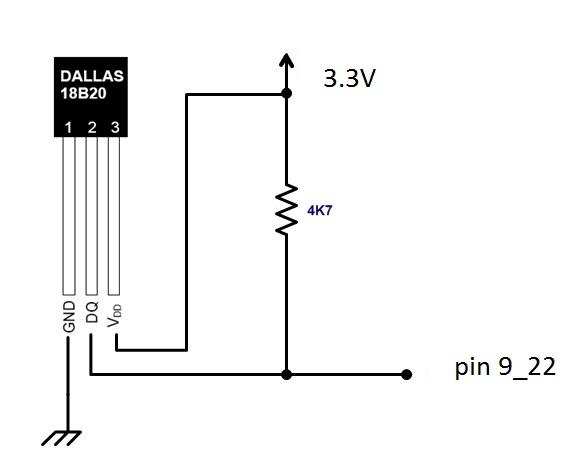Then, you must be using a 3.8.x kernel. Right ? But here are the modules
needed at least on a 4.x kernel:
william@beaglebone:~/dev/bb.org-overlays$ lsmod |grep w1
w1_therm 4886 0
w1_gpio 3764 0
wire 35398 2 w1_gpio,w1_therm
All three of those need to be loaded in order for the DS18B20 to work. So,
try manually loading those via modprobe. SO let's take a look at a rPI
blogpost:
https://www.modmypi.com/blog/ds18b20-one-wire-digital-temperature-sensor-and-the-raspberry-pi
Much of this blog post is going to be RaspberryPI centric. *dtoverlay=w1-gpio,
*/boot/config.txt, etc. However if you scroll down to the *"Programming" *part
of the blog post. This person talks about loading the required kernel
modules( also note that kernel version is 3.6.11 ) Using modprobe. So if
you run those two modprobe commands, and then list the contents of
/sys/bus/w1/devices:
*william@beaglebone:~$* ls /sys/bus/w1/devices/
28-00000647ddf6 w1_bus_master1
And you get output like the above. 1-wire *is* working, and the 1-wire
master ( beaglebone ) has detected a 1-wire slave device. It's working.
However, if you load both the above 1-wire kernel modules, and there is
nothing in /sys/bus/w1/devices, then something is wrong. I'd have to say at
this point, if you do not get an error about a missing module, that you
have your pin muxed incorrectly, or not properly connected to the pin.
Now if you get an error on the command line from trying to load either of
those two 1-wire modules. Chances are pretty good you haven't compiled in
the given proper 1-wire support. In fact, I do believe there is a whole
section in menu-config for 1-wire devices. You may actually have to
recompile your kernel with support for the DS18B20 1-wire device . . .
Another issues between 4.x, and 3.8.x kernels is that device enumeration
was different for some devices. So . . . It is entirely possible, in your
overlay, that the GPIO bank you're passing in as parameters is off by one.
How can be test for this ? On 4.x kernels . . .
*william@beaglebone:~$* ls /sys/devices/platform/ocp
40300000.ocmcram 48042000.timer 480ca000.spinlock
49800000.tptc driver_override
40302000.ocmcram_nocache 48044000.timer 4819c000.i2c
49900000.tptc modalias
44e07000.gpio 48046000.timer 481ac000.gpio
49a00000.tptc ocp:l4_wkup@44c00000
44e09000.serial 48048000.timer 481ae000.gpio
4a100000.ethernet of_node
44e0b000.i2c 4804a000.timer 481d8000.mmc
4c000000.emif power
44e35000.wdt 4804c000.gpio 48200000.interrupt-controller
53100000.sham subsystem
44e3e000.rtc 48060000.mmc 48310000.rng
53500000.aes uevent
47400000.usb 480c8000.mailbox 49000000.edma
56000000.sgx
*william@beaglebone:~$* ls /sys/devices/platform/ocp/44e07000.gpio/gpio/
gpiochip0
And the very first gpio address entry in this case was the lowest gpio
bank. So, if you investigate the equivalent directory in 3.8.x, you should
be able to check all gpio banks, to see what the actual lowest gpio bank
is. Do also keep in mind that /sys/devices/platform/ocp/ will be different
in 3.8.x. So you'll have to poke around a bit. Unless someone else posts
here and gives you the proper path. I don't remember what it is.
Anyway, there is another option. You can upgrade your kernel to a newer
version. Which, yes, will probably mean you'll also have to either flash a
newer image, or run a newer image from sdcard.

 In the future
In the future